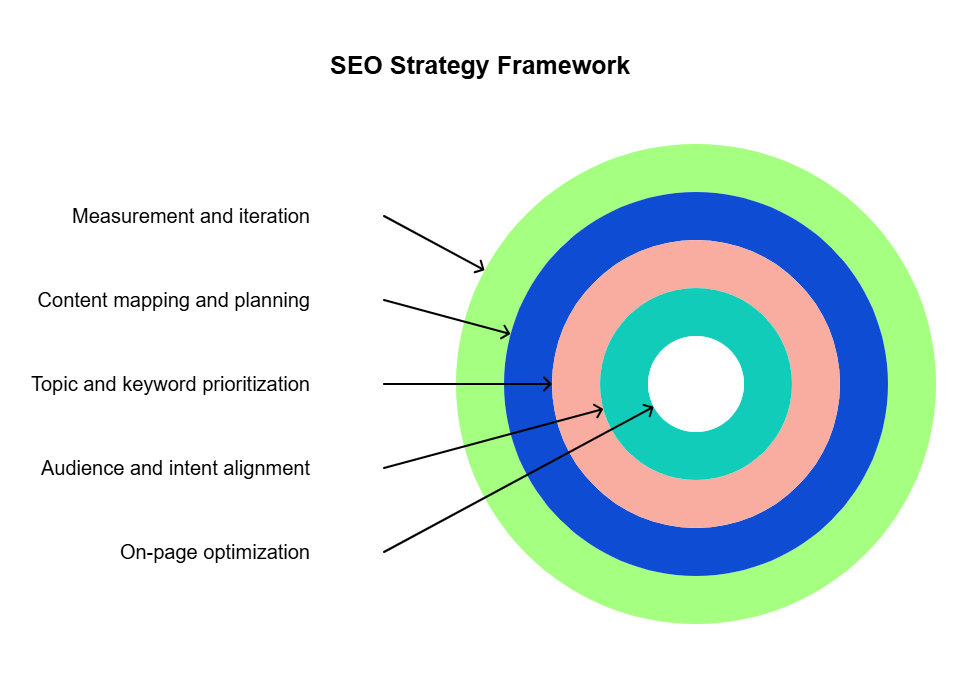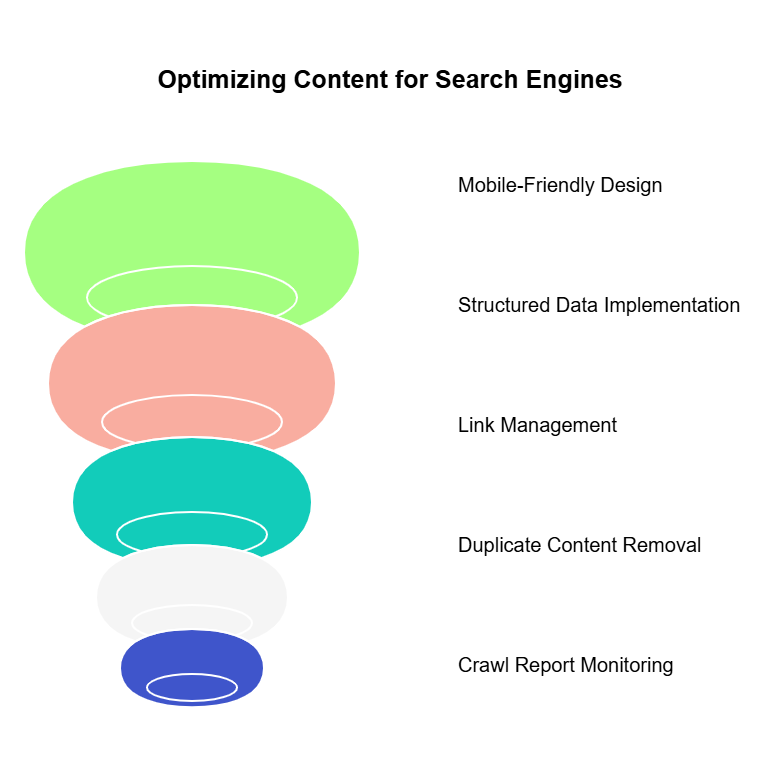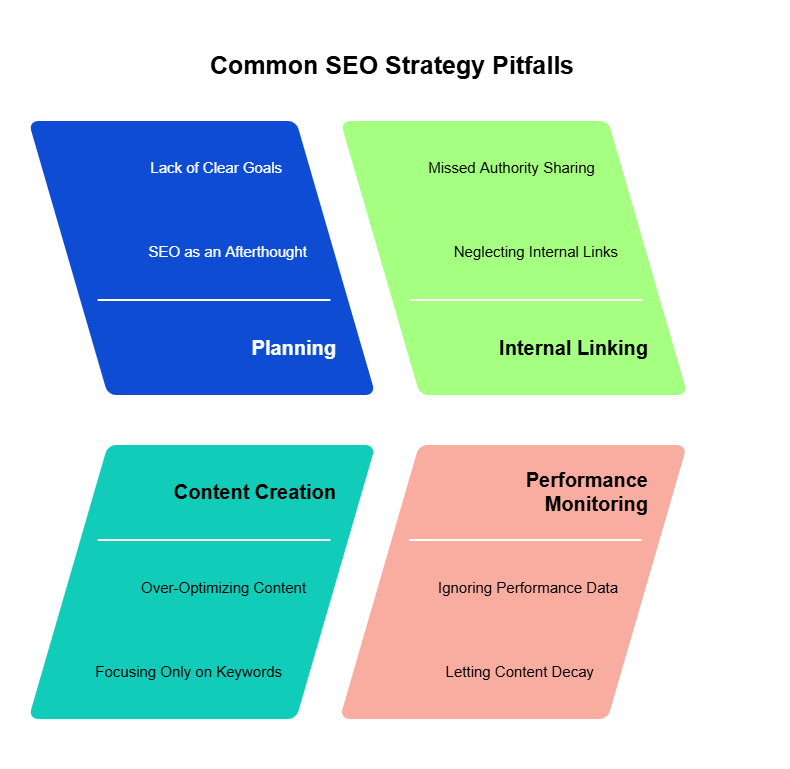You pick a keyword and write an article. Then you pick another. Then another.
If that sounds like your content strategy (or lack thereof), you’re probably struggling to get any eyeballs on your site. In fact, you probably aren’t on Google’s radar at all.
That’s because search engines don’t reward scattered effort. They reward structure, consistency, and intent. Random blog posts might cover good topics, but without a strategy behind them, they don’t work together. They don’t build authority. They don’t signal relevance. And they definitely don’t drive results.
To get real traction, you need a system: an SEO content strategy. One that helps you choose the right topics, interconnect them, and publish content that grows your visibility over time.
What is SEO content strategy?
SEO content strategy is the plan that guides how you create, structure, and optimize content so it supports your search goals and business outcomes.
Essentially, it’s the guide that governs what topics to cover, how those topics connect, who the audience is, what search intent you’re targeting, and how you’ll measure success.
The strategy helps you prioritize content that matters, rather than create one random blog post after another. It’s the difference between publishing more and publishing with purpose.
Over time, your SEO content strategy should create real search demand and long-term visibility, not just temporary traffic spikes.
Most importantly, your strategy is not static. It should change over time as you learn more about your audience and the kinds of content that meet your goals.
SEO strategy vs. the content
Strategy is the plan that organizes your work, but SEO content refers to the actual assets you publish: the blog posts, guides, landing pages, and videos that are optimized for search.
Without strategy, SEO content is just isolated pages. With strategy, you’re building an intentional network of content that works together to grow your visibility and authority over time.
The content experience
Content experience is becoming one of the most important search engine optimization factors. Search engines have gotten better at evaluating not just the relevance of your content, but the quality of the experience that surrounds it.
The content experience is where UX meets SEO. It’s what turns good content into great content by making it easier to access, easier to trust, and easier to use.
What does this look like in terms of your SEO content strategy?
Information architecture
Your site should be structured so users can easily navigate from one piece of content to the next. Clear page hierarchies, smart internal linking, and intuitive menus help users and search engines understand how your content fits together.
If your best pages are buried or disconnected, Google will assume that they aren’t significant. Nor will it gain a deeper contextual understanding of that content. The result is poor performance.
Google’s EEAT framework
E-E-A-T (experience, expertise, authoritativeness, and trust) adds another layer.
Google wants to serve content from reliable sources, especially for queries that impact health, finance, or safety. That means every part of the content matters: who wrote it, how it's presented, whether it’s backed by credible sources, and whether it’s up to date.
Including author bios, citing trustworthy references, and offering a clean, ad-free reading experience can all help reinforce trust.
Performance and design
A page that loads slowly, is cluttered with popups, or doesn’t work on mobile will frustrate users. Search engines take note of this.
Improving readability, simplifying layout, and making your site accessible all contribute to a better content experience.
The pillars of SEO content strategy

The difference between “doing SEO” and doing it well comes down to whether you’ve built your strategy on the right foundation.
1. Audience and intent alignment
Start with a deep understanding of your audience and what they’re searching for. Focus on search intent: what they actually want to accomplish when they type a query.
The goal here is to make sure your content marketing solves real problems and matches their expectations.
2. Topic and keyword prioritization
You’ll need to perform extensive keyword ranking research to identify the queries your audience uses to find high quality content. Then prioritize those keywords based on search volume, competition, and relevance to your business.
It often helps to group keywords into themes so you can build topic authority instead of chasing random rankings.
3. Content mapping and planning
Plan content around journeys, not just keywords. Use topic clusters and internal linking to connect related pages. Craft pillar pieces that serve big ideas. Then create sub-articles that expand on each pillar’s topic.
Focus on quality here. Make sure every piece of content has a clear purpose, whether it’s to inform, entertain, convert, or support another piece.
4. On-page optimization
Google's contextual understanding of content is fairly sophisticated these days, but it still requires some structure to really understand our intent.
Use headers, primary and related keywords, metadata, image tags, and clear formatting to help search engines understand your content. Write with clarity and use keywords naturally so your content performs without sounding forced.
Keep accessibility in mind as well. The principles of accessibility and SEO often overlap, so you can serve both goals with the same on-page optimizations.
5. Measurement and iteration
Track what’s working. Go beyond rankings and look at engagement, conversions, and visibility across search features like featured snippets, AI overviews, or video results. Use this data to refine your strategy, identify gaps, and double down on what performs.
Don’t be afraid to revisit old content. In fact, search engines love that practice. Update your information, make stronger points, and include more media.
6. Workflow and process
A strategy is meaningless without solid execution. Create workflows for your content team, including writers, designers, publishers, data analysts, and any stakeholders who participate in the process.
Scaling your content means giving everyone clear roles, objectives, and deadlines. Most importantly, give people enough autonomy to make the content as quality as possible.
7. Technical SEO
Even the best content can underperform if technical issues block search engines from crawling or indexing it.
Your strategy should include some way to handle the technical side of SEO, including site speed, mobile-friendliness, crawlability, structured data, and internal linking. Without these elements, even the most well-written, optimized content can fail to rank.
Best practices for SEO integration
Once you’re armed with your SEO strategy, the next question is, “How do you convert the strategy into actual content?”
Step 1: Start with SEO in the planning stage
SEO integration begins before a single word is written. Use keyword and topic research to guide what content you create but go deeper than just volume. Focus on intent: what your audience wants to learn or do.
Organize your content calendar around SEO content marketing clusters and themes that support your business goals.
- Pillar article: How to Audit Your Site for Accessibility Issues
- Supporting article: The Complete Accessibility Checklist for Enterprise Websites
- Supporting article: How [Client] Improved Compliance with Accessibility Fixes
- Supporting article: Accessibility in 2025: What You Need to Know
- Supporting article: Common Accessibility Mistakes (and How to Fix Them)
- Supporting article: How Accessibility Impacts SEO and User Experience
Furthermore, make sure SEO and content stakeholders align on the purpose of each piece before it hits the writing phase.
Step 2: Get your creators on the same page
Even the best strategy falls flat if your creators don’t understand it.
Writers, designers, and subject matter experts need to know what the SEO goals are, who the content is for, and how their work fits into the bigger picture.
Sorry, but a list of keywords won’t cut it. You’ll need to share the intent behind the content, the problems it's solving, and the role it plays in the overall plan.
When creators understand the “why,” they make smarter choices, stay on brand, and deliver engaging content that performs without sacrificing voice or clarity. A simple kickoff, a clear content outline or brief, or even a short async video can go a long way in aligning everyone.
Step 3: Write with structure and search in mind
As you draft content, optimize with a light touch. Use headers to guide readers and signal structure to search engines. Include your primary and secondary keywords naturally, and don’t force it. Make sure meta titles, descriptions, and slugs reflect the topic clearly.
Pay attention to formatting too. Bullet points, short paragraphs, and clear subheadings improve readability and performance.
If you create content briefs for writers and other creators, use templates to make sure all of the important bits make it into the draft. But don't be afraid to stray from those templates if the content requires it.
Step 4: Build a workflow for regular audits and updates
Publishing a piece isn’t the end of the road. SEO-rich content needs upkeep to stay competitive.
Schedule quarterly or biannual audits to identify content that’s losing traffic or rankings. Refresh stats, rewrite outdated sections, and look for ways to improve internal linking.
If you’re worried about the expense of working with old content, think of it more like preserving your marketing assets.
Step 5: Don’t forget technical SEO touchpoints

Even great content can underperform if technical issues block search engines from crawling or indexing it.
- Make sure each page is mobile-friendly and loads quickly (PageSpeed Insights helps).
- Add structured data where appropriate to help content appear in rich results.
- Add internal links and fix broken links
- Eliminate duplicate content if it pops up
- Keep an eye on crawl reports to catch issues early.
It helps to write your own content optimization checklist for each page. Someone on your team should run through the checklist quickly for each page to make sure your ducks are in a row.
Step 6: Promote and distribute strategically
SEO and content promotion work best together. Once a piece is live, share it across your owned and earned channels. Email newsletters, social media, and internal linking can give it an initial boost.
For evergreen pieces, consider outreach strategies to earn backlinks over time. Repurpose high-performing content into other formats like infographics, videos, or slide decks to reach new audiences.
Essential SEO content optimization tools
A strong SEO content strategy needs good tools at every step. They provide structure, automation, and — most importantly — the data you need to make smart decisions.
Admittedly, there's no shortage of digital marketing tools. We could probably find a hundred for each stage in your content production pipeline. What’s important, however, is that you find the right tools that meet your specific needs.
But it helps to know where tools add the most value to your SEO content strategy.
SEO research and topic planning
Planning tools help you discover what your audience is searching for, how competitive the space is, and where the biggest opportunities lie.
Platforms like Ahrefs, Semrush, and Google Keyword Planner offer deep keyword analysis, content gap insights, and competitor benchmarking. Google Trends can help you discover what's topical.
Siteimprove goes beyon this by combining search data with content quality scoring so you can prioritize based not only on traffic potential but also on content health.
Keyword optimization and content briefing
These platforms bridge the gap between SEO goals and your actual content. And remember, we want to give search engines a contextual understanding of the content, not simply optimize for a keyword.
So instead of handing writers a keyword list, tools like MarketMuse generate structured, AI-assisted briefs that show which topics to cover, which terms to include, and how deep to go. They take into account what already ranks on the search engine results page and help you write something that can compete.
Most importantly, these kinds of optimizers help you achieve that contextual understanding by optimizing for a category of keywords that relate to a primary keyword.
As your team moves into the writing and editing phase, content creation and collaboration tools come into play. These aren’t SEO tools in the traditional sense, but they’re crucial for turning insights into action.
- Google Docs remains a go-to for many teams thanks to its simplicity and integrations with SEO add-ons.
- Notion helps with editorial planning and team coordination.
- Contentful supports structured content workflows that scale across pages and platforms.
On-page optimization checkers
On-page SEO and optimization checkers make sure everything you produce meets technical standards. For WordPress users, Yoast SEO and Rank Math handle things like title tags, meta descriptions, and readability checks.
Siteimprove takes a more enterprise-level approach by combining SEO audits with accessibility testing, quality checks, and content performance scoring in one unified dashboard. This is especially helpful when multiple teams touch the same content.
Performance monitoring and reporting
This is where you track rankings, clicks, conversions, and find out what’s working. Google Search Console gives you direct insight into how your pages are performing in organic search. Google Analytics helps you understand user behavior.
Siteimprove stands out again here with its ability to monitor SEO, accessibility, and content quality all at once. If you need to visualize data across platforms, Databox can make customizable dashboards for different stakeholders.
Track the metrics that matter to your goals
It’s easy to get caught up in surface-level SEO metrics like rankings, impressions, traffic. But these numbers don’t always tell the full story.
What really matters is how your content supports your business objectives. A successful content marketing strategy tracks performance through the lens of outcomes, not just visibility. That’s to say you should only care about the metrics that reflect real value.
Start by aligning your metrics with intent. If a piece is designed to drive awareness, you might measure pageviews, scroll depth, or social shares. If it’s meant to generate leads, focus on conversion rates, demo requests, or form fills. For thought leadership, you might look at engagement metrics, backlinks, and brand mentions.
The key is to connect each content asset to its purpose and track performance based on that goal.
It’s also important to evaluate content as part of a system. A blog post might not convert on its own, but if it supports a high-converting landing page or cluster, it’s still doing its job.
Look beyond last-click attribution and consider the full user journey. Use tools that can help you track assisted conversions, behavioral paths, and content influence across sessions.
Finally, don’t forget about internal metrics. How quickly is your team publishing? How often is content refreshed? Are key pieces being updated and linked to? Operational performance plays a major role in content success, especially at scale.
When you focus on the numbers that matter most to your business, you’re better equipped to prove your impact and defend your budget. It’s the kind of stuff your stakeholders love to see because it helps them make good decisions.
Common SEO strategy pitfalls

Even with a solid strategy, it’s easy for execution to slip. Small missteps can erode your content’s performance and hurt the performance of your content over the long-term.
- Treating SEO as an afterthought: Waiting until after a piece is written to optimize it usually results in awkward edits and missed opportunities. SEO needs to shape the content from the start.
- Focusing only on keywords, not topics: Chasing individual keywords creates fragmented content that often competes with itself. Prioritizing topics and clusters builds authority and structure, which Google likes to see.
- Over-optimizing content: It’s tempting to stuff your content with keywords to appease Google, but this can hurt readability and alienate users. Great content balances SEO requirements with natural language.
- Neglecting internal linking: If your content doesn’t connect to other pages on your site, it misses out on shared authority and user navigation benefits.
- Publishing without a clear goal: Content without a defined purpose — whether it’s to rank, convert, or support another asset — usually fails to perform. It’s also boring to read.
- Ignoring performance data: Skipping content audits or avoiding analytics makes it impossible to improve. Without feedback, your strategy stays stuck on assumptions.
- Letting content decay: Old content that’s no longer accurate, optimized, or useful can drag down site performance. Update your library to stay fresh and competitive.
The future of SEO content strategy
As user behavior shifts and search technology advances, the way you plan and create content needs to keep up. No, you don’t have to chase every tool and new trend. But you need to understand what’s on the horizon so you can adapt accordingly.
Generative AI
One of the biggest shifts is the rise of AI in content planning and optimization. Tools are getting better at analyzing search intent, clustering keywords, and even generating outlines or first drafts.
But the real value comes from how teams use AI. Not to replace creators, but to speed up research, identify gaps, and strengthen strategic decisions.
Conversational search
Another major trend is conversational and voice search. People aren’t typing keywords the same way they used to. They’re asking full questions, using natural language, and expecting direct, relevant answers.
This means your content needs to be more conversational too. You have to meet the user where they are, in the language they use.
Zero-click content
Lastly, zero-click results and AI-generated answers are changing how much traffic actually makes it to your site. That doesn’t mean SEO is dead (though many SEO specialists will claim as much), but it means your content has to work harder to provide value, build trust, and capture attention whether or not the user clicks through.
Content with purpose
A strong SEO content strategy gives your content purpose. It keeps your team focused, your topics connected, and your work aligned with your goals. Instead of chasing rankings one blog post at a time, you can build long-term visibility that compounds over time.
Siteimprove helps bring that strategy to life. It gives you the insight to choose the right topics, the tools to optimize content as you create it, and the reporting to measure what’s working. It helps you turn strategy into sustained performance.

